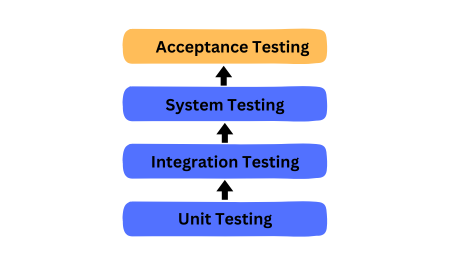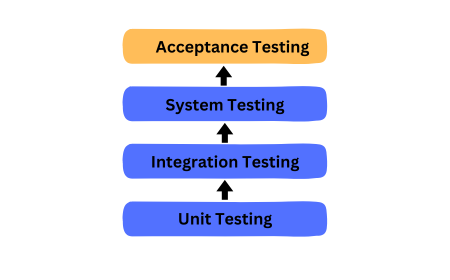What is Acceptance Testing? A Comprehensive Guide
 Pavlin
Pavlin
In the software development life cycle, Acceptance Testing holds a crucial position, emphasizing the customer's perspective and judgment. This phase, especially vital for customer-specific software, involves the active participation of the end user.
Let's delve into the intricacies of acceptance testing, exploring its various forms and significance.
What is Acceptance Testing?
The Customer's Involvement
The focus is on the customer's perspective and judgment
Acceptance testing is unique as it directly engages the customer. This ensures that the tests are comprehensible to the end user, who might even hold the primary responsibility for the process. Performing tests in an environment resembling the customer's setup adds authenticity to the evaluation.
| Aspect | Description |
| Focus | The focus is on the customer's perspective and judgment, ensuring a user-centric approach to acceptance testing. |
| Engagement | Acceptance testing directly engages the customer, making it unique in its approach to involve end users actively. |
| Comprehensibility | Tests are designed to be comprehensible to the end user, emphasizing clarity and understanding of the testing process. |
| Responsibility | In certain cases, the end user might hold the primary responsibility for the acceptance testing process. |
| Environment | Testing is performed in an environment resembling the customer's setup, adding authenticity to the evaluation. |
| Customer-Specific Software | Especially crucial for customer-specific software, tailoring the testing process to the unique needs of the customer. |
| Active Customer Involvement | The customer is actively involved in the acceptance testing process, ensuring their direct input and participation. |
| Understanding | Acceptance testing is designed to be the only test the customer needs to understand, simplifying the evaluation process. |
| Main Responsibility | The customer might have the main responsibility for certain aspects of acceptance testing, contributing to the testing process's success. |
| Environment Similarity | Testing is performed in an environment as similar as possible to the target environment, enhancing the relevance of the evaluation. |
| Potential for New Issues | Testing in a customer's-like environment may lead to the identification of new issues that may not surface in other testing phases. |
Types and Forms of Acceptance Testing

Typical aspects of acceptance testing:
Contract fulfillment verification
User acceptance testing
User acceptance testing
Operational (acceptance) testing
Field test (alpha and beta testing)
| Form of Acceptance Testing | Description |
| Contract Fulfillment Verification | Testing according to the terms of the contract to ensure the development or service contract is achieved. |
| User Acceptance Testing | Involves multiple user groups to ensure different expectations are met; rejection by any group can be problematic. |
| Acceptance Testing In Advance | Execution within lower test levels, like integration or component testing, for early issue detection. |
| Operational (Acceptance) Testing | Focuses on acceptance by system administrators, covering backup/restore cycles, disaster recovery, user management, maintenance tasks, and security vulnerabilities. |
| Field Testing | Testing in diverse environments; includes alpha testing at the producer's location and beta testing at the customer's side. |
Table outlining the various forms of Acceptance Testing
Acceptance Testing Contract Fulfillment Verification

Acceptance Testing According to the Contract
Acceptance testing plays a pivotal role in ensuring that software development or service contracts are fulfilled as agreed upon.
Here's a breakdown of the key components:
Is the development/service contract accomplished:
- The primary objective is to verify that the terms and conditions outlined in the development or service contract have been successfully implemented.
Is the software free of (major) deficiencies:
- This aspect focuses on identifying and rectifying any significant deficiencies within the software. It aims to deliver a product that meets quality standards.
Acceptance Testing Criteria
Acceptance criteria form the foundation of the acceptance testing process, providing specific guidelines for evaluation:
Determined in the development contract:
- The criteria for acceptance are predetermined during the development contract phase. These criteria serve as benchmarks for evaluating the software's performance.
Any regulations that must be adhered to:
- Beyond contractual agreements, acceptance testing also ensures compliance with external regulations. This may include governmental, legal, or safety regulations that the software must adhere to.
User Acceptance Testing
User acceptance testing (UAT) is a critical phase that involves assessing the software from the end user's perspective:
The client might not be the user:
- Acknowledging that the client and end user may be distinct entities. UAT involves catering to the needs and expectations of the actual users.
Every user group must be involved:
- Recognizing the diversity among user groups and involving each group in the testing process to capture varied expectations.
Different user groups may have different expectations:
- Understanding that various user groups may have unique expectations, and addressing these differences is crucial for overall acceptance.
Emphasizing the significance of addressing concerns from every user group. Even rejection by a single group can have implications for the success of the software.
Acceptance Testing In Advance
Acceptance testing need not be confined to the final stages of the software development life cycle. Executing acceptance tests in advance, at lower test levels, allows for early detection of issues and a more proactive approach to quality assurance.
During integration
During the integration phase, acceptance tests can be seamlessly integrated into the process. This ensures that the software components work cohesively, meeting acceptance criteria before reaching the final stages.
Commercial Off-the-Shelf (COTS) Software
When dealing with COTS software, conducting acceptance tests is crucial. Verifying its compatibility and adherence to predefined criteria ensures that the off-the-shelf solution aligns with specific project requirements.
Component Testing
Acceptance testing at the component level is essential for assessing individual components' usability. This detailed examination guarantees that each component functions as intended, contributing to the overall success of the software.
Before System Testing
Conducting acceptance tests before the comprehensive system testing phase allows for the identification and resolution of issues at an earlier stage. This proactive approach minimizes potential setbacks during later stages of development.
Using a Prototype
Utilizing a prototype for acceptance testing provides an opportunity to validate new functionalities. This hands-on approach allows stakeholders to interact with a tangible representation of the software, ensuring alignment with expectations.
For New Functionality
Ensuring acceptance tests cover new functionalities is paramount. This proactive approach guarantees that any additions to the software meet predefined acceptance criteria and contribute positively to the overall user experience.
Field Testing
Testing in Real-world Environments
Field testing involves running the software in diverse environments, acknowledging that all variations cannot be replicated in a controlled test environment.
Software on Many Environments
Recognizing the diversity in the environments where the software may operate, field testing aims to uncover issues that may not be apparent in controlled conditions.
Testing with Representative Customers
Field testing includes alpha testing, conducted at the producer's location, and beta testing, carried out at the customer's side. These tests involve representative customers and provide valuable insights into real-world usage scenarios.
Alpha Testing
Carried out at the producer's location, alpha testing allows for thorough testing in a controlled environment, uncovering potential issues before wider distribution.
Beta Testing
Conducted at the customer's side, beta testing involves real users and real-world conditions. This phase helps identify issues that may only become apparent in diverse and unpredictable environments.
In summary, acceptance testing in advance, operational acceptance testing, and field testing collectively ensure a comprehensive evaluation of the software's functionality, performance, and usability in diverse scenarios. This proactive and thorough approach contributes to the overall success of the software development process.
Conclusion
In conclusion, acceptance testing, whether in terms of contract fulfillment, predefined criteria, or user acceptance, ensures that the developed software aligns with expectations and requirements, paving the way for a successful deployment.
Subscribe to my newsletter
Read articles from Pavlin directly inside your inbox. Subscribe to the newsletter, and don't miss out.
Written by
